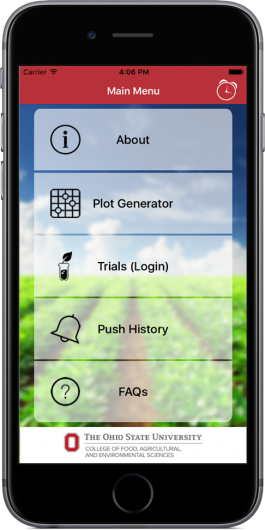Every summer, harmful algae blooms invade many bodies of water, such as Buckeye Lake and Lake Erie. In 2014, the toxic algae level in Lake Erie reached a record high, leaving more than 400,000 people in Toledo with unsafe tap water. This algae issue is triggered by excessive fertilizers that are washed off into rivers.

The OSU PLOTS application was designed to help improve farmer’s operations management while reducing fertilizer runoff which causes algae blooms in lakes. Credit: Courtesy of Ohio State
In an attempt to solve this issue, Ohio State researchers turned to their smartphones.
Researchers recently created an app called OSU PLOTS. It’s designed to improve farmers’ management operations by instructing them how much fertilizer, water, shade and pesticide to use on their land, and where to use them, with the goal of decreasing runoff.
“Our goal was to take the app, and make it a tool to help farmers at least be thoughtful of what they are doing on their farms as a way to just be better stewards of the land,” said Kaylee Port, project coordinator in the Department of Food, Agriculture and Biological Engineering who worked on the app.
Although there are many apps to help farmers manage their fields, OSU PLOTS is the only one that helps them increase productivity and save money with data, said Sam Custer, a researcher in OSU Extension.
“I think it will continue to be used by more and more researchers, more and more farmers to make those good research-based decisions,” Custer said.
The app has a random number generator to organize the layout of plots, which are sections in a field, in an attempt to remove the human error of dividing fields.
After plots are numbered, the app creates on-farm trials to help farmers test treatments and select the best one for different fields.
Once the trials are created, farmers can use the app to record their treatments throughout the growing season. The data gathered includes fertilizers and pesticides they use, seeding populations, planting spacing and depth and insect and disease issues.
“What’s really nice is, if you are using your app, it kind of helps cut back on the amount of time because you can more centrally focus your efforts on certain areas of the field,” Port said.
After the harvest, the app produces a summary report that statistically analyzes all the data. The report enables growers to compare the treatments and yields.
Because the app’s design is simple, users can analyze their fields without being statisticians, Port said.
“Anybody that wants to grow something, in theory, could use this app,” Port said.


